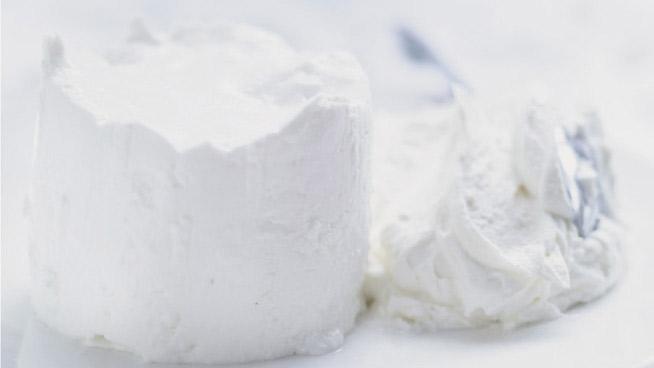As the oldest known by-product of milk, fresh cheese was the first cheese made by a set process. The basic pro¬cedure involves adding a lactic starter to milk, then immediately draining the resulting curds. Fresh cheese is neither fermented nor ripened: it is simply transferred to a perforated mould that allows the whey to drain off and gives the cheese its final shape. Today, moulds are made of plastic, but in former times they were fashioned from reeds, terracotta, faience or porcelain. And the practice is indeed ancient: 8,000-year-old pottery shards, perforated for draining cheese, have been found in Switzerland.
A world of curds
People the world over enjoy fresh cheese for its light, tangy flavour. Its texture may be smooth and rich or slightly crumbly. In the United States and Great Britain, cottage cheese is by far the most popular fresh cheese. In France, the cheese called Petit-Suisse is eaten by the spoonful, often with a sprinkle of sugar. Brocciu is the pride of Corsica, and is protected by the guaranteed origin system familiar to wine lovers, AOC (Appellation d’origine contrôlée). In Italy, versatile ricotta finds its way into cakes and stuffed pastas, fresh mozzarella is classically paired with tomatoes and basil, and mascarpone is an essential ingredient in the signature Italian dessert, tiramisu. The Greeks have their famous feta, often eaten with bread and olives or crumbled into salads; for centuries, this cheese has been considered so essential that it is stored in brine in order to ensure a steady supply. Indian cuisine features its own fresh cheese, paneer, which is often cut into small cubes and served with spinach or peas. Lebanon is home to a large assortment of fresh cheeses, including labneh, halloumi and baladi. The Mexicans, for their part, put queso fresco in such dishes as quesadillas and black bean soup.
In Canada, fresh cheese most often takes the form of cottage cheese and cream cheese. We also like our quark and especially our cheese curds, without which poutine simply wouldn’t be poutine. Kids also have a big appetite for fresh cheese with fruit.
All kinds of milk—cow, goat, sheep, water buffalo—are used in the production of these remarkably varied fresh cheeses. Feta, for example, is traditionally a sheep’s milk cheese. Perhaps the most famous product of Italy’s Campania region, mozzarella di bufala (water buffalo mozzarella), is protected by the Italian equivalent of France’s AOC system. Some fresh cheeses, such as ricotta and brocciu, are whey-based, although nowadays some ricotta is made with milk. Richer cheeses such as mascarpone, Petit-Suisse and cream cheese are enriched with cream.
Nutritionnally speaking
Since they aren’t aged, fresh cheeses have more moisture than their ripened counterparts, anywhere from 50 to 86% total moisture. “That’s why they’re kept refrigerated in the grocery store and have a short shelf life, usually between a few days and about three weeks. It’s also why they’re called fresh cheese,” says Daniel St-Gelais, a microbiologist specialized in milk processing and a researcher with Agriculture and Agri-Food Canada. “To enjoy their flavours to the fullest, it’s best to eat them when they’re very fresh. That gratifying squeak when you eat cheese curds, for example, only happens when the curds are a day or two old. Later on the cheese will still be good, but will have lost some of its sensory appeal.”
The fat content of fresh cheeses ranges from very low to quite high, depending on whether the cheese was made with skimmed, partially skimmed or whole milk or includes added cream. Most of these cheeses are excellent parts of a healthy diet, with the exception of regular cream cheese and mascarpone. The following table summarizes the fat content of selected fresh cheeses.
Fresh cheese is a good source of protein as part of a meal or a hearty snack, but it has less calcium than ripened cheese, particularly hard varieties. A serving of cottage cheese (125 g) has four times less calcium than a glass of milk.
They're versatile
Fresh cheeses are extremely useful in the kitchen because many of them work in both sweet and savoury preparations. Depending on your mood, you can pair them with fresh fruit, honey, vanilla, dried or candied fruit, citrus zest, orange blossom water, maple syrup or chocolate. On the savoury side, try them with herbs, garlic, pepper, spices, nuts, olive oil, vegetables or smoked fish.
A number of them are also interchangeable in recipes. For example, cottage cheese can stand in for ricotta in savoury dishes. For sweets, quark is the better substitute because it’s traditionally considered a dessert cheese.
Have some fun exploring fresh cheeses all by themselves a spoonful at a time! At breakfast, serve bowls of cottage cheese or quark garnished with fruit and a little maple syrup, honey or jam. Buckwheat crepes or galettes stuffed with ricotta are simply divine. At lunch time, instead of cream cheese, spread some labneh or ricotta on a bagel. Making sandwiches? A slice of fresh mozzarella adds a nice twist, as do feta or curds in a salad. When you make dip, experiment with different kinds of fresh cheese. And be sure to try out our irresistible recipes. Then sit back, relax and bask in the beauty of summer.
Cheese and their approximate %MF
Quark = 0,1 to 0,25%
Faisselle (ask your cheesemonger for this fresh cheese made in Quebec and France)= 0,5% and higher
Cottage = 1 to 4%
Fresh cheese with fruits = 3%
Ricotta = 10%
Bocconcini and fresh mozzarella = 18 to 20%
Reduced-fat cream cheese = 19%
Feta = 22%
Regular cream cheese = 23 to 31%
Curds = 29%
Mascarpone = 35 to 50%
"People the world over enjoy fresh cheese for its light, tangy flavour. Its texture may be smooth and rich or slightly crumbly."

